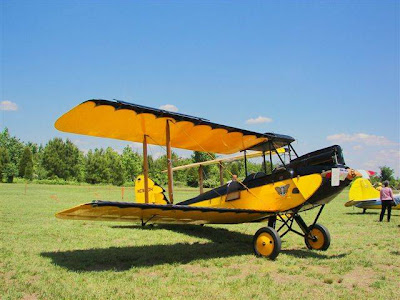I know that this sounds weird for those who are not familiar with this thing. Also, for entomologists who been studying about bugs all life, gypsy moth is something different and when I saw this news, as a bugman I was very curious to know about it. After reading it, I started searching more about it. Its definitely not the insect that we are talking here about. Read for yourself. A pilot and his passenger walked away with just minor injuries after their 1930s bi-plane crashed into a field near Perth Airport yesterday. The de Havilland DH60G Gipsy Moth came down minutes after takeoff when the engine of the vintage aircraft failed, around 11.55am. Pilot Ray Palmer, 64, managed to steer the aircraft into a field of oil seed rape, where it flipped over after landing. He and his 57-year-old passenger, who has not been named, were left with just minor injuries but it is understood that the plane was damaged beyond repair. The Gipsy Moth is the model of aircraft piloted by legendary British aviator Amy Johnson when she became the first woman to fly solo from Britain to Australia in 1930. It is said to have contributed vastly to the growth of private and sport flying and was used for many great aviation feats. Yesterday one resident who lives near the airport said: "It looks like the plane has nose dived as it has come in to land. It is nose first in to the ground and its tail is up in the air.
 "It doesn't look as if the plane will be flying again anyway - it is very badly damaged." Mr Palmer, of Weybridge, Surrey, is a regular visitor to Perth Aerodrome near Scone, which he uses to temporarily store and refuel his plane while visiting Scotland. He had been staying in the Perth area over the weekend and had gone to the aerodrome yesterday morning to take his plane out on a local flight. Ian Ferguson, secretary of the Scottish Aero Club, said: "Well done to the pilot for doing the right thing and following the necessary steps for an emergency landing. It was absolutely the right thing to do, bringing the aircraft down in a field. He's got it safely down to ground level, but it was bad luck for him that he brought it down in a field of oil seed rape." Mr Ferguson said that the high crop would have led to the plane flipping over after it landed. "The crop would have wrapped around its undercarriage and pulled it over. If it's just a field of grass or potatoes, it probably wouldn't have caused the damage it did."
"It doesn't look as if the plane will be flying again anyway - it is very badly damaged." Mr Palmer, of Weybridge, Surrey, is a regular visitor to Perth Aerodrome near Scone, which he uses to temporarily store and refuel his plane while visiting Scotland. He had been staying in the Perth area over the weekend and had gone to the aerodrome yesterday morning to take his plane out on a local flight. Ian Ferguson, secretary of the Scottish Aero Club, said: "Well done to the pilot for doing the right thing and following the necessary steps for an emergency landing. It was absolutely the right thing to do, bringing the aircraft down in a field. He's got it safely down to ground level, but it was bad luck for him that he brought it down in a field of oil seed rape." Mr Ferguson said that the high crop would have led to the plane flipping over after it landed. "The crop would have wrapped around its undercarriage and pulled it over. If it's just a field of grass or potatoes, it probably wouldn't have caused the damage it did."
Mr Ferguson said the slow speed of the aircraft contributed to the safety of the pilot and his passenger. "It's actually not that surprising they were relatively unhurt. This sort of vintage aircraft travels fairly slowly and you can land them really slowly. It would have come down at quite a slow speed." He added: "I believe it is beyond economic repair. These things are pretty irreplaceable, like vintage cars." Tayside Police and fire service attended after they were alerted to the situation, but no action was required. A police spokeswoman said: "Tayside Police received reports of a crash landing close to Perth Airport at 11.55am whereby a small plane got into difficulties shortly after take off. The pilot and the passenger, aged 64 and 57, escaped uninjured. "Initial inquiries indicate the plane suffered from a loss of power due to a mechanical failures, however further investigation is ongoing." via The Herald.

Comments